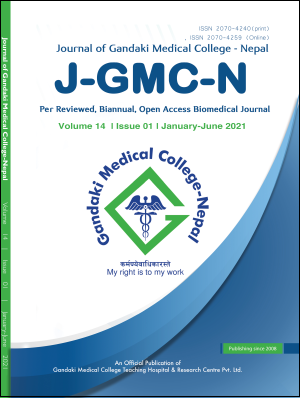Disrespect and abuse during facility-based childbirth in Pokhara metropolitan city
DOI:
https://doi.org/10.3126/jgmcn.v14i1.30572Keywords:
Childbirth, Disrespect and Abuse, Facility, PokharaAbstract
Introduction: Respectful maternity care is the universal right of every childbearing woman, which promotes the practices that recognize women’s preferences and women’s and newborns’ needs. The objective of the study was to assess disrespect and abuse during facility-based childbirth in Pokhara.
Methods: Postnatal mothers having vaginal institutional delivery were included in the study. Non-probability purposive sampling technique was done to select 231 samples. Face to face interview technique with structured interview schedule was used. Descriptive and inferential statistics were used for data analysis.
Results: Most (88.3%) of the mothers were between the age of 20 and 34 years with the mean age of 25.39±4.799 years. More than half of them had spontaneous vaginal delivery with episiotomy and (87%) of mothers had no any complications during childbirth. The overall disrespect and abuse during facility-based childbirth was (70.1%) and only (29.9%) of the postnatal mothers received respectful and non-abusive care. Regarding types of disrespect and abuse, (34.6%) of them were suffered from physical abuse, (68%) received non-consented care, (22.5%) of them received non-confidential and non-dignified care, (1.3%) experienced discrimination based on specific attributes and (26%) suffered from abandonment or neglect of care. There was no significant association between the prevalence of disrespect and abuse with socio-demographic and obstetric characteristics of the mothers. The association was found with place of delivery.
Conclusion: It is concluded that near to three fourth of the postnatal mothers suffer from disrespect and abuse during facility based child birth in Pokhara. Thus, to increase respectful and non-abusive care during facility based childbirth, practice of respectful maternity care should be promoted including development of clinical guidelines and protocols.
Downloads
Downloads
Published
How to Cite
Issue
Section
License
This license allows reusers to distribute, remix, adapt, and build upon the material in any medium or format for noncommercial purposes only, and only so long as attribution is given to the creator.




